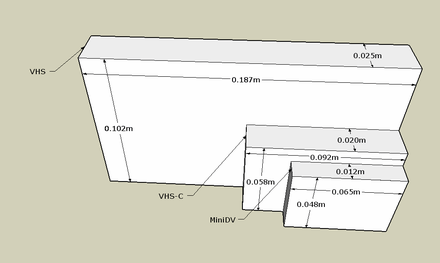VHS-C
VHS-C is the compact VHS videocassette format, introduced by Victor Company of Japan (JVC) in 1982,[1] and used primarily for consumer-grade compact analog recording camcorders. The format is based on the same video tape as is used in VHS, and can be played back in a standard VHS VCR with an adapter.[2] Though quite inexpensive, the format is largely obsolete even as a consumer standard and has been replaced in the marketplace by digital video formats, which have smaller form factors.
 | |
VHS-C Cassette Adapters (rear) and VHS-C cassette (front) | |
| Media type | Magnetic tape |
|---|---|
| Encoding | NTSC, PAL |
| Capacity | 30, 60 minutes |
| Standard | Interlaced video |
| Dimensions | 92 × 58 × 20 mm (3⅔ × 2¼ × ¾ in) |
| Usage | Home movies |

The magnetic tape on VHS-C cassettes is wound on one main spool and used a gear wheel which moves the tape forward. It can also be moved by hand. This development hampered the sales of the Betamax system somewhat, because the Betamax cassette geometry prevented a similar development.
VHS-C cassette was larger than Video8 cassette, but was compatible with VHS tape recorders, using a special adapter cassette. The adapter contains a standard full-size engagement hub for the VCR's takeup sprocket, which connected to a gear train to drive the VHS-C cassette takeup gear.
VHS end of tape is normally detected by a light in the VCR that inserts into the full-size cassette body, and detected by sensors in the VCR located at the far outer corners of the front of the cassette. Because the width of VHS-C is narrower than a full-size VHS cassette and does not align with the full-size end of tape sensors, the adapter has a guide roller swing arm to pull tape out of the VHS-C cartridge out to the far right edge where it would normally be located in a full-size cassette. When the VHS-C cartridge is to be removed from the adapter, a geared retraction system pulls in the excess loose tape when the swing arm retracts.
A higher quality version of VHS-C was released, based on S-VHS, known as S-VHS-C, that competed against Hi8, the higher quality version of Video8. The arrival on the market of inexpensive S-VHS-C camcorders led to the inclusion on many modern VCRs of a feature known as SQPB, or SuperVHS Quasi-PlayBack, but did not make a significant impact on the market as the arrival of MiniDV as a consumer standard made low-cost, digital, near-broadcast quality video widely available to consumers, and rendered analog camcorders largely obsolete.
Compared with Video8, VHS-C had similar video quality but a shorter run time, 90 versus 30 minutes at SP speed (for standard cassettes), 180 versus 60 for longer-running modes. JVC did market 45-minute and 60-minute SP Mode tapes with the Extra High Grade formulation (135 minutes and 180 minutes in EP/SLP Mode) for a time. Similarly, Video8 spawned a 120-minute version of the cassette (240 minutes in long play).

The later Hi8 and S-VHS-C systems both have a quality similar to the laserdisc system.
Although Video8 acquired a digital variant, Digital8, D-VHS was never adapted to a compact format, as the consumer camcorder industry moved on to small-format MiniDV tapes, then hard-drive- and DVD-based machines, and then solid-state storage.
Slackening Problem
Early VHS-C cassettes did not have a mechanism to ratchet or lock the supply reel when not in use, making them susceptible to spilling tape inside the shell. Consequently, manufacturers placed a label on their camcorders and adapters to warn the user to check that the tape is not slackened before inserting a cassette. The user could dissipate the slack by manually turning the take-up gear. Later cassettes corrected this problem by adding teeth to the supply reel to lock it in place when no upward pressure is applied. The spindle of the camcorder or VCR supplies pressure to float the reel's turntable and teeth above the shell, allowing it to rotate freely when in use.
If a tape with slack was loaded into a VHS-C adapter, the tape could sit on the wrong side of a tape guide when the adapter loaded. The result would be a tape and cassette combination that would not play in a video deck, and would damage the tape to some extent when being unloaded.
Write Protect Imperfection
VHS-C cassettes have a switch to inhibit recording of a cassette. Not all adapters propagate the state of this switch to the VCR itself, so accidental erasure of a write-protected cassette is possible if the adapter's write protect lug or switch allows it.
VHS-C head drum
To reduce the size of cameras, the VHS-C mechanism uses a two-thirds size head drum (41.3 mm diameter instead of the original VHS drum size of 62 mm). The wrap angle is 270 degrees instead of VHS's 180 degrees. The drum rotates at a proportionately higher speed, and four rotary video heads are used to trace out exactly the same helical recording path as a standard sized VHS drum. By adding more heads, the same small VHS-C drum can record and playback FM Hi-Fi audio that is also fully compatible with a standard sized Hi-Fi video drum.
References
- "1982 VHS-C". Victor Company of Japan Ltd. (JVC). Archived from the original on April 2, 2007. Retrieved 2007-08-06.
HR-C3 The first model of portable VCR to use VHS-C cassette
- "Videointerchange.com". Videointerchange.com. Retrieved 2020-02-20.
External links
- youtube.com How to put VHS-C videos into Computer - Easy!
- youtube.com V2 Tech Video View - Dynex VHS-C -to- VHS Cassette Adapter
- MediaCollege.com The VHS-C Format
- panasonic.com VHS-C FAQ